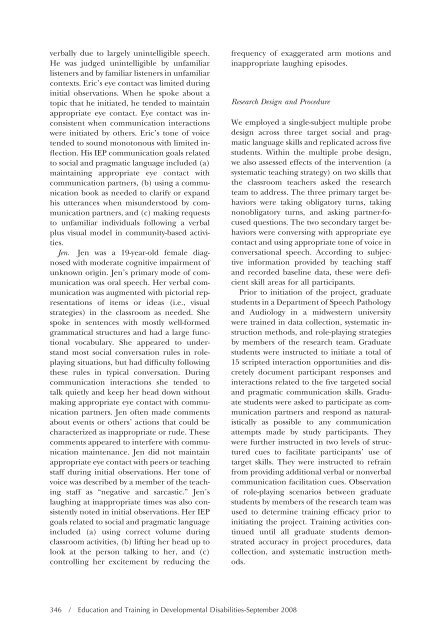Download the Journal (PDF) - Division on Autism and ...
Download the Journal (PDF) - Division on Autism and ...
Download the Journal (PDF) - Division on Autism and ...
Create successful ePaper yourself
Turn your PDF publications into a flip-book with our unique Google optimized e-Paper software.
verbally due to largely unintelligible speech.<br />
He was judged unintelligible by unfamiliar<br />
listeners <strong>and</strong> by familiar listeners in unfamiliar<br />
c<strong>on</strong>texts. Eric’s eye c<strong>on</strong>tact was limited during<br />
initial observati<strong>on</strong>s. When he spoke about a<br />
topic that he initiated, he tended to maintain<br />
appropriate eye c<strong>on</strong>tact. Eye c<strong>on</strong>tact was inc<strong>on</strong>sistent<br />
when communicati<strong>on</strong> interacti<strong>on</strong>s<br />
were initiated by o<str<strong>on</strong>g>the</str<strong>on</strong>g>rs. Eric’s t<strong>on</strong>e of voice<br />
tended to sound m<strong>on</strong>ot<strong>on</strong>ous with limited inflecti<strong>on</strong>.<br />
His IEP communicati<strong>on</strong> goals related<br />
to social <strong>and</strong> pragmatic language included (a)<br />
maintaining appropriate eye c<strong>on</strong>tact with<br />
communicati<strong>on</strong> partners, (b) using a communicati<strong>on</strong><br />
book as needed to clarify or exp<strong>and</strong><br />
his utterances when misunderstood by communicati<strong>on</strong><br />
partners, <strong>and</strong> (c) making requests<br />
to unfamiliar individuals following a verbal<br />
plus visual model in community-based activities.<br />
Jen. Jen was a 19-year-old female diagnosed<br />
with moderate cognitive impairment of<br />
unknown origin. Jen’s primary mode of communicati<strong>on</strong><br />
was oral speech. Her verbal communicati<strong>on</strong><br />
was augmented with pictorial representati<strong>on</strong>s<br />
of items or ideas (i.e., visual<br />
strategies) in <str<strong>on</strong>g>the</str<strong>on</strong>g> classroom as needed. She<br />
spoke in sentences with mostly well-formed<br />
grammatical structures <strong>and</strong> had a large functi<strong>on</strong>al<br />
vocabulary. She appeared to underst<strong>and</strong><br />
most social c<strong>on</strong>versati<strong>on</strong> rules in roleplaying<br />
situati<strong>on</strong>s, but had difficulty following<br />
<str<strong>on</strong>g>the</str<strong>on</strong>g>se rules in typical c<strong>on</strong>versati<strong>on</strong>. During<br />
communicati<strong>on</strong> interacti<strong>on</strong>s she tended to<br />
talk quietly <strong>and</strong> keep her head down without<br />
making appropriate eye c<strong>on</strong>tact with communicati<strong>on</strong><br />
partners. Jen often made comments<br />
about events or o<str<strong>on</strong>g>the</str<strong>on</strong>g>rs’ acti<strong>on</strong>s that could be<br />
characterized as inappropriate or rude. These<br />
comments appeared to interfere with communicati<strong>on</strong><br />
maintenance. Jen did not maintain<br />
appropriate eye c<strong>on</strong>tact with peers or teaching<br />
staff during initial observati<strong>on</strong>s. Her t<strong>on</strong>e of<br />
voice was described by a member of <str<strong>on</strong>g>the</str<strong>on</strong>g> teaching<br />
staff as “negative <strong>and</strong> sarcastic.” Jen’s<br />
laughing at inappropriate times was also c<strong>on</strong>sistently<br />
noted in initial observati<strong>on</strong>s. Her IEP<br />
goals related to social <strong>and</strong> pragmatic language<br />
included (a) using correct volume during<br />
classroom activities, (b) lifting her head up to<br />
look at <str<strong>on</strong>g>the</str<strong>on</strong>g> pers<strong>on</strong> talking to her, <strong>and</strong> (c)<br />
c<strong>on</strong>trolling her excitement by reducing <str<strong>on</strong>g>the</str<strong>on</strong>g><br />
frequency of exaggerated arm moti<strong>on</strong>s <strong>and</strong><br />
inappropriate laughing episodes.<br />
Research Design <strong>and</strong> Procedure<br />
346 / Educati<strong>on</strong> <strong>and</strong> Training in Developmental Disabilities-September 2008<br />
We employed a single-subject multiple probe<br />
design across three target social <strong>and</strong> pragmatic<br />
language skills <strong>and</strong> replicated across five<br />
students. Within <str<strong>on</strong>g>the</str<strong>on</strong>g> multiple probe design,<br />
we also assessed effects of <str<strong>on</strong>g>the</str<strong>on</strong>g> interventi<strong>on</strong> (a<br />
systematic teaching strategy) <strong>on</strong> two skills that<br />
<str<strong>on</strong>g>the</str<strong>on</strong>g> classroom teachers asked <str<strong>on</strong>g>the</str<strong>on</strong>g> research<br />
team to address. The three primary target behaviors<br />
were taking obligatory turns, taking<br />
n<strong>on</strong>obligatory turns, <strong>and</strong> asking partner-focused<br />
questi<strong>on</strong>s. The two sec<strong>on</strong>dary target behaviors<br />
were c<strong>on</strong>versing with appropriate eye<br />
c<strong>on</strong>tact <strong>and</strong> using appropriate t<strong>on</strong>e of voice in<br />
c<strong>on</strong>versati<strong>on</strong>al speech. According to subjective<br />
informati<strong>on</strong> provided by teaching staff<br />
<strong>and</strong> recorded baseline data, <str<strong>on</strong>g>the</str<strong>on</strong>g>se were deficient<br />
skill areas for all participants.<br />
Prior to initiati<strong>on</strong> of <str<strong>on</strong>g>the</str<strong>on</strong>g> project, graduate<br />
students in a Department of Speech Pathology<br />
<strong>and</strong> Audiology in a midwestern university<br />
were trained in data collecti<strong>on</strong>, systematic instructi<strong>on</strong><br />
methods, <strong>and</strong> role-playing strategies<br />
by members of <str<strong>on</strong>g>the</str<strong>on</strong>g> research team. Graduate<br />
students were instructed to initiate a total of<br />
15 scripted interacti<strong>on</strong> opportunities <strong>and</strong> discretely<br />
document participant resp<strong>on</strong>ses <strong>and</strong><br />
interacti<strong>on</strong>s related to <str<strong>on</strong>g>the</str<strong>on</strong>g> five targeted social<br />
<strong>and</strong> pragmatic communicati<strong>on</strong> skills. Graduate<br />
students were asked to participate as communicati<strong>on</strong><br />
partners <strong>and</strong> resp<strong>on</strong>d as naturalistically<br />
as possible to any communicati<strong>on</strong><br />
attempts made by study participants. They<br />
were fur<str<strong>on</strong>g>the</str<strong>on</strong>g>r instructed in two levels of structured<br />
cues to facilitate participants’ use of<br />
target skills. They were instructed to refrain<br />
from providing additi<strong>on</strong>al verbal or n<strong>on</strong>verbal<br />
communicati<strong>on</strong> facilitati<strong>on</strong> cues. Observati<strong>on</strong><br />
of role-playing scenarios between graduate<br />
students by members of <str<strong>on</strong>g>the</str<strong>on</strong>g> research team was<br />
used to determine training efficacy prior to<br />
initiating <str<strong>on</strong>g>the</str<strong>on</strong>g> project. Training activities c<strong>on</strong>tinued<br />
until all graduate students dem<strong>on</strong>strated<br />
accuracy in project procedures, data<br />
collecti<strong>on</strong>, <strong>and</strong> systematic instructi<strong>on</strong> methods.
















